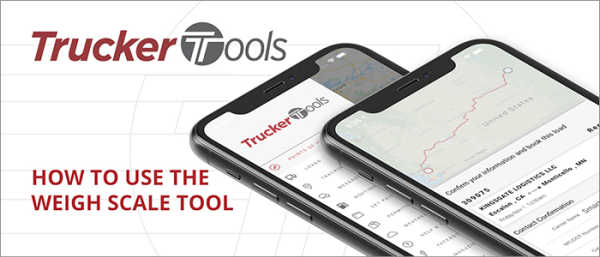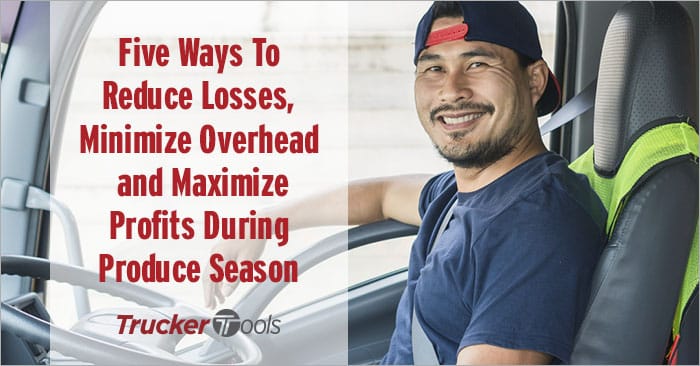Spring is here — finally! With spring comes one of the busiest times of the year for reefer drivers: produce season. The produce growing season in the continental United States typically starts in late March/ early April and ends in November. With produce season now in full swing in Florida and Texas, and fruits and vegetables coming across the border from Mexico and Central America, it’s the perfect time to look at how you can reduce your expenses and maximize your profits as a reefer driver or carrier. We recently surveyed reefer drivers across the country to gather produce-hauling tips and tricks that you can use yourself to make this season a smooth and profitable one. Check out these five tips for reducing losses, minimizing overhead and maximizing profits during produce season.
1. Follow All Safety Protocols
Ensuring that the produce you haul stays fresh and safe for people to eat is important for obvious reasons. Delivering food that isn’t safe to consume may hurt your relationships with shippers and brokers, cause you to lose money on loads, literally make people sick, and subject you to injunctions or even criminal prosecution. It’s no surprise then that forty-seven percent of the truckers we surveyed told us that following safety protocols should be a top priority when you’re pulling produce. Maintaining the proper temperatures on your produce loads is, of course, a big part of produce safety. It also gives fruits and vegetables a longer shelf life once they’re delivered to grocery stores. It’s important to fully understand and follow all food safety requirements issued by shippers.
2. Make Sure Your Reefer Meets FMSA Standards
The more produce is moved and handled, the more vulnerable it becomes to contamination, which is why the Food and Drug Administration has specific standards in place that govern how you clean and maintain your reefer trailer. The FDA’s Food Safety Modernization Act (FSMA) includes seven major rules. One of the rules, the Sanitary Transportation Rule, sets specific requirements for refrigerated trucks. According to FSMA regulations, your reefer must be cleanable and include adequate temperature controls. You also must prevent ready to eat food (like produce) from touching raw food, from contamination by non-food items and from cross-contact with other foods. Carriers must provide food safety training to all operations personnel. You also must maintain records of your written procedures and training. To learn more, visit https://www.fda.gov/food/food-safety-modernization-act-fsma/fsma-final-rule-sanitary-transportation-human-and-animal-food.
3. Know Your Weight Distribution
Weight distribution is important on any load, but it’s particularly important with produce. Proper weight distribution provides stability and improves steering ability, ultimately keeping you and the produce that you’re pulling safe and sound. Poor weight distribution can cause roll-overs, affect traction and even damage your tires. If you’re new to hauling reefer, keep in mind that your reefer trailer weighs more than a flatbed or dry van trailer because of the weight of the refrigeration unit and the extra insulation in the walls of the trailer. Because of this, produce loads tend to be heavy loads that are harder to scale. Need help calculating your axle weights or finding a weigh scale to check your weight? You can do both with Trucker Tools’ free app for truckers.

4. Keep Fuel Costs, Deadheading as Low as
Possible
In our survey, we asked truckers how they minimize their overhead expenses during peak produce season. Several truckers who responded to our survey told us that they keep their operating costs low and profit margins as high as possible by seeking out the cheapest fuel that they can along their routes. You can find the cheapest fuel on your route with the Route & Fuel Optimizer in Trucker Tools’ free driver app. Respondents to our survey also said that keeping deadheading to a minimum helps them maximize their revenue during produce season. The Trucker Tools driver app also makes it quick and easy for you to find backhauls with your favorite brokers.
5. Find Cool, Shaded Areas To Park
Sometimes it’s the simplest things that do the trick. As one of the truckers who responded to our survey noted, you can “find cool, shaded areas to park” to take some of the burden off your refrigeration unit. When temperatures soar in the summer months, seeking out shaded areas may help you reduce the amount of fuel required to keep your produce loads at the proper temps. Sitting in the shade during your breaks also feels a whole lot better for you when temperatures and the humidity are especially high.
For more produce hauling tips and insights from our recent produce survey, read Seven Best Practices for Produce Season: Key Takeaways from Trucker Tools’ Recent Produce Survey. To download Trucker Tools’ free driver app, visit https://www.truckertools.com/carriers/.






